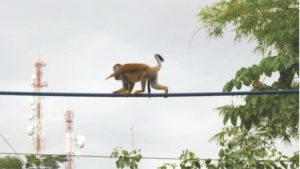By Danielle Lynch
As a recipient of the Provost’s Advanced Research/Creative Endeavor Award, environmental studies major Katra Laidlaw has a rare opportunity to examine the effects of wildlife-crossing structures on arboreal wildlife.
This competitive award provides financial and academic support to outstanding undergraduate students who are pursuing advanced research and creative endeavors. Each student is mentored by a Northeastern faculty member in the completion a unique project of the recipient’s own design.
It all started with a family vacation in Costa Rica, where she stayed at a hotel connected to a wildlife rehabilitation center, Kids Saving the Rainforest. In the lobby, Katra and her sister chatted with a New York Times reporter who was interviewing the president of Kids Saving the Rainforest. They were offered a 50% discount on a tour, where Katra soon learned about the amazing wildlife and their current projects, including the Monkey Bridge Project. During her stay, she also attended a wildlife rehabilitation conference which helped to inform her decision to return to Costa Rica for a co-op and a second independent research project.
Katra became interested in biological corridors, or areas of habitat connecting wildlife populations otherwise fragmented by natural or human causes, during her study abroad experience in Costa Rica in 2014. During her time there, she completed her first independent field study project to see whether an agro-forestry system could serve as a biological corridor to the surrounding secondary and primary forest.
Kids Saving the Rainforest has installed over 130 rope bridges across local roads to allow arboreal wildlife to cross safely and link up viable habitat as part of their Monkey Bridge Project. Katra’s research at the wildlife rehabilitation center intends to examine the effectiveness of wildlife-crossing structures in reducing road-related deaths and mitigating habitat fragmentation. She plans to assess the status of existing bridges, re-evaluate their deployment in developing areas, and use ArcMap to create an accurate map of the area including viable corridors of habitat. This will be done through a combination of daytime observations and nighttime data collection using infrared camera traps. In developing this project, Katra was encouraged to work with Stephanie Eby, a faculty member she had never even met before, who was a terrestrial ecologist with experience using GIS (geographical information systems) technology to study fire ecology in the African savannah.
Katra has come a long way since her enrollment as an undeclared student four years ago. She said that this uncertainty about choosing a major allowed her to explore new fields (such as landscape architecture) that she didn’t even know existed when she was in high school. Attending information sessions and scheduling meetings with advisors helped her the most as a freshman, because those connections turned into important resources. “Although it is hard to approach professionals that you don’t know,” she said, “it is a valuable practice that will most likely lead to some exciting and unexpected experiences in the future. Remember, the worst thing they can say is no.”


